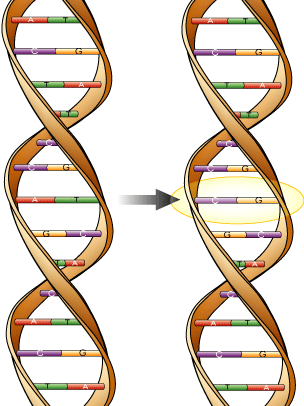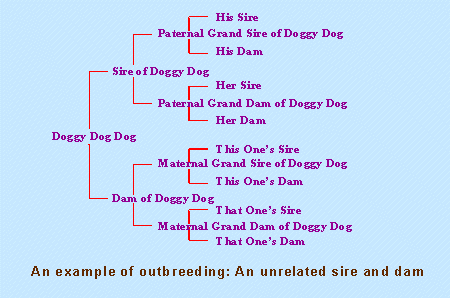BIJOU STANDARD POODLES
WHAT DOES COI MEAN ?
"the farther backward you look the further forward you can see" - Winston Churchill
 ...
...

COI stands for Coefficient Of Inbreeding and is the calculation
used to determine the level of inbreeding on an idividual dog or puppy.
The higher the number for COI the closer the dog or puppy was inbred.
A very low COI reflects that that dog or puppy was "outcross" meaning the parents of the dog or puppy
had little or no common ancestors. A low COI breeding should really appeal to those individuals
leaning towards obtaining a designer breeds (mutts) as basically a COI of less than 10% would be the equivalent
of a mutt breeding, but with the beauty, health and characteristics of a purebred and a breeder's health guarantee and support.
��
High COI percentages of
over 20% increase the probability that genetic defects will be carried from
common ancestors
on both sides of the pedigree and will match up to cause the actual genetic disease or defect in the animal.
Many other problems of a
high COI also affect dogs, such as Autoimmune disease
and inbreeding depression symptoms, which result in reproductive and longevity
issues,
IF and only IF there are health problems in the lines to begin with.
A COI of 12.5% is
equivalent to a half brother to half sister mating or a grandparent to
grandchild mating.
This breeding is the most
common practice for breeders wishing to achieve consistency in type or to "cement"
certain traits.
As a result the litter should be fairly uniform in type and temperament which is the goal for anyone breeding for Type/showing.
This breeding is usually referred to as a "line-breeding" and is one of the
BEST breedings to achieve PERFECTION.
COI is a "tool" used by knowledgeable breeders to plan, eliminate, procure and evaluate their breeding program
and not as just a number that dictates if a breeding is a good or a bad one.
I believe it is important for the public and breeders to recognize that world famous Standard Poodle Breeders such as
Jean Lyle of Wycliffe Poodles had COI's of well over 40% on her poodles that lived well and long
or her "AM/CAN CH Wycliffe Michael" whose 10 generation COI of 93.32% and who was heavily used in siring over 33 litters at least.
Gord and Michelle McIntyre of Torbec Kennel (who are no longer) with her famous apricots had COI's of 30% - 40%
such as Torbec Eclipse of the Sun, who lived to be 15 years of age.
A COI of 25% is equivalent to a parent-child or brother to sister mating.
This type of breeding is really not recommended by anyone. It is a very "tight" breeding and is usually referred to as "inbreeding".
A breeder could either get really amazing healthy great looking pups as a result, with pups that will have great
genotype (ability to reproduce its self) and great phenotype (the pup will visually appear close to ideal for its breed)
for the desired breed type, OR the opposite and look poorly and be very skiddish, hyper, aggressive, unhealthy pups as a result.
So this breeding will either produce the best or the worst traits of their parents.
Ideally, the COI of a
litter should not exceed the average COI of the two parents. It is highly
recommended to avoid a COI in excess of 20%.
Homozygous means having inherited the same "gene" for a particular trait from both parents
e.g. for dentition, coat colour or disease. Barring random mutation, 100% of the offspring of a homozygous individual will inherit that gene.
Inbreeding increases homozygosity by "Cementing" a particular trait good or bad gene.
Knowledgeable breeders want good qualities "cemented" and to breed away from bad qualities.
Health testing through established DNA tests helps us breeders produce Prepotent individuals with good qualities cemented.
Purebred animals display a high degree of homozygosity compared to mixed breeds and random-bred animals.
The idea of purebred animals is that they should "breed true". When one purebred is mated with another of the same breed,
the offspring will have uniform characteristics and will resemble the parents.
I get asked all the time how we achieve reds that hold their colour.
In order to achieve dark red colour a breeder has to start with the dark red colour.
You can't take two light coloured dogs and achieve dark red colour that is going to hold.
You can't take a light coloured Poodle and breed it to a dark red Poodle and achieve dark red pups that will hold colour
UNLESS it is a linebreeding on dark red ancestor which will usually be a Majestic dog or VERY old Palmares Lines.
Which will mean a COI of 6% or greater on the litter.
Line breeding on a dark red Poodle ancestor will "bring forth" that dark red gene.
Because very few breeders are concentrating on "Colour Breeding", finding "real" dark reds that hold their colour
and have passed all OFA testing, is near impossible in 2010 and will continue to be impossible
Until more breeders stop using fading reds, apricot and creams in their red programs.
Buyers will find that the only "real" dark reds they can find as of 2010 will have a 10-generation COI of 6% and up.
Once red breeders start concentrating on "Colour" (assuming OFA's are completed of course) THEN
we can acheive colour from outcross breedings like breeders are doing with the more common colours.
Red breeders need to concentrate on health testing of course...but also on colour breeding.
Our BEST breedings of producing that rich Dark Irish Setter Reds have been 10-generation COI = 7.18%
My BEST Dark Brown breeding with exceptionally sweet temperaments in 1980's was a 10-generation COI = 15.27% (now in 2012 it is 0.11% or less)
You can see these reds and browns on our web page as pups as adults that have held their colour
and are exceptionally healthy, completing all OFA health testing and DNA testing available.
COI is a great "tool" to assist breeders, but breeders CAN'T ignore genetics and expect to get results.
Click to read article about Pedigree
Some genetically
inherited diseases and faults in Purebred and Mutts alike, are:
Hip and elbow dysplasia
Patella Luxation
Epilepsy
Eye disease such as: cataracts, Collie
Eye Anomaly (CEA) and
Progressive
Retinal Atrophy (PRA)
Cancer
Allergies and skin problems
Retained testicles
Autoimmune diseases
Bad bites and missing teeth
Unacceptable colors
Temperament problems such as shyness
and aggressiveness
Inbreeding depression symptoms are seen as the loss of viability or function resulting from excess inbreeding.
Sometimes these syptoms are very subtle and gradual and are often blamed on diet, pollution and other environmental factors.
While these factors may also contribute, it is the dogs genes that make it more susceptible.
The most frequently seen inbreeding depression signs are:
Chronic poor health/poor
keepers
Higher incidence of disease in a line (or breed) of one or more diseases
than is seen in the breed or canines as a whole
Higher incidence of immune system
diseases
Unusually small litter size
Difficulty in getting and keeping
bitches pregnant
Bitches that abandon a litter or are
poor mothers
Bitches that kill or damage puppies
intentionally or by lack of care
Studs that are indifferent to a bitch
in standing heat
Studs that cannot breed without help
Low sperm count
Earlier average age of death in a line
or in the general breed population
All of these factors make it incredibly important that you do the COI calculation
on any planned litter. Keeping the breed healthy is easier than cleaning it up after the fact.
COI calculation can give the breeder an indication of how inbred a dog or litter will be.
Knowing this percentage will enable you to make the best choices towards reducing inbreeding in your dogs.
Today the emphasis should be put on health, temperament and working ability if purebred dogs are
going to survive into the next hundred years.
Active concern for health should be your number one breeding goal, because without health, you have no dog.
 ...
...
